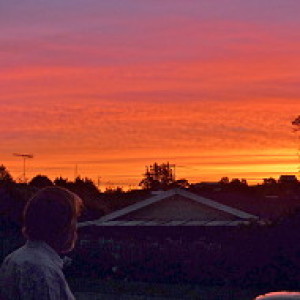Motukorea
The island of Motukorea was formed by a series of volcanic eruptions at a time when the Tamaki Estuary and Waitemata Harbour were forested river valleys. A series of wet explosive eruptions created a 1 km wide crater. The gritty debris from the walls of the vent, mixed with magma-sourced ash formed a large tuff ring, a remnant of which survives as the island's high eastern ground (to the left of the high cone). Fragments of fossil shells are found in the tuff layers, having been thrown out as the eruptions burst through a shell bed which lay under the Tamaki river valley of the time.
After the initial eruptions, dry fire fountaining built up a numberof scoria cones within the crater. Lava flows appear to have carried away parts of a number of the cones. The lava flowed mainly to the west and south, and is now largely under the sea, having swept away the tuff ring on those sides of the island. The highest point of the island now is the large scoria cone on the left which has a deep summit crater; this was created by the final phase of fire-fountaining.
Motukorea is the only volcano in Auckland where tuff ring, scoria cone and lava flows are visible in the one reserve. It is also one of the least modified of Auckland’s volcanoes.
It is regarded as a taonga (treasure), and has been an important part of Auckland's early history. Historic sites cover much of the island and include Maori pa sites, gardens and settlements, in some cases several hundred years old. Motukorea was once extensively settled and cultivated by Maori. Remains of stone-walled gardens, still in use when the first Europeans visited in 1820, can still be seen in the valley southeast of the cone. Sites of former campsites and settlements cover much of the island, the earliest dating back 500-800 years.
Ngati Tamatera lived on Motukorea (island of the pied oystercatcher) for at least six centuries. There were three pa (fortified villages) on the island; the largest was on the summit of the main volcanic cone. Recent archaeological findings show the island was intensively gardened and fished.
Motukorea was one of the first European land purchases in the Auckland region; being bought by William Brown and John Logan Campbell in 1840 from Ngati Tamatera. They settled on the island (the Ngati Tamatera built them a large raupo whare (house made from raupo) and established a pig farm to supply the emerging mainland settlement of Auckland.
When Auckland was proclaimed the capital of New Zealand as expected, they left the island to focus on business affairs on the mainland. Brown (whose name gave the English name for the island) and Campbell sold the island in 1873 and it was farmed by two families in succession until 1946.
In 1946 the island was bought by the Auckland Metropolitan Drainage Board as part of a plan to build a sewerage treatment plant on the island. This was abandoned after considerable public opposition.
Sir Ernest Davis bought the island and presented it as a gift to the people of Auckland in 1955. Ownership remains with the Auckland City Council, although the island is managed by the Department of Conservation as part of its administration of the Hauraki Gulf Maritime Park.

Comments
Sign in or get an account to comment.


